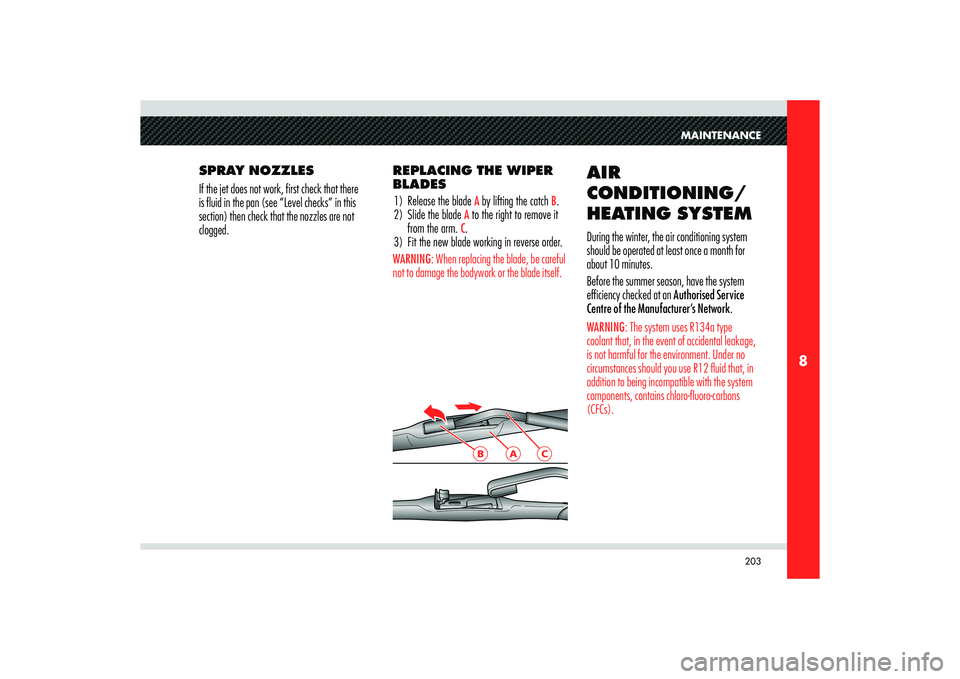Release Alfa Romeo 8C 2008 Owner handbook (in English)
[x] Cancel search | Manufacturer: ALFA ROMEO, Model Year: 2008, Model line: 8C, Model: Alfa Romeo 8C 2008Pages: 223, PDF Size: 14.35 MB
Page 170 of 223

168
6
B
C
A
IF THE BATTERY IS
FLAT First of all, we recommend that you read
the precautions contained in the section
”Maintenance“ to prevent the battery from
running flat and to help ensure its long life.
STARTING WITH THE
AUXILIARY BATTERY
See the chapter ”Starting the engine“ on page
114 in the section ”Using the vehicle”.WARNING: Under no circumstance should a
battery be used for an emergency start-up: This
could damage the electronic systems, particularly
the control units managing the ignition and fuel
supply functions.
RECHARGING THE
BATTERY
You are advised to recharge the battery slowly
and at a low amperage for about 24 hours.
Proceed as follows:
1) Deactivate the electronic alarm using the
radio control.
2) Lift the rear shelf
A and the box cover
B
and release the hooks
C.
WARNING: First disconnect the negative pole
terminal (–) then the positive pole one (+).3) Connect the battery charger cables to the
battery poles.WARNING: The battery is housed in a metal box, therefore, be extremely careful not to let the
battery charger clips come into contact with it.
4) Turn on the battery charger.
5) When the battery is recharged, turn off the
battery charger before disconnecting it from
the battery.
6) Reconnect the terminals to the battery
poles, observing the polarity.WARNING: First reconnect the positive pole
terminal (+) and then the negative pole one
(–).
WARNING: Before reconnecting the battery
terminals, check that the key has been removed
from the ignition or at least that it is in the STOP
position.
Page 204 of 223

202
8
CAUTION
During the tyre life, the rolling
direction of the first fitting shall
always be observed, also in case of
“non-directional” tyres.
CAUTION
Check the depth of the tyre
tread at regular intervals (minimum
allowed value 1.6 mm). The thinner
is the tread, the greater is the risk of
skidding.
CAUTION
Drive carefully on wet roads to
decrease the risk of aquaplaning.
WINDSCREEN
WIPERSClean the rubber parts regularly using the
appropriate products.
Change the blades if the edge of the rubber
is deformed or worn. In any case, the blades
should be changed about once a year.
CAUTION
Travelling with worn wiper
blades is very dangerous because it
reduces the visibility in the event of
poor atmospheric conditions.
CAUTION
The arms of the wiper blade
have to be replaced with new ones
after having disassembled them twice.
The special arm fixing system ensures
optimal mechanical stability only after
the first two refitting operations,
provided that the specified tightening
torque is observed.CAUTION
We advise you to have any
operations involving removal of the
windscreen wiper arms performed at
an Authorised Service Centre of the
Manufacturer’s Network.
Some simple measures may reduce the
possibility of damage to the blades.
- In the case of temperatures below zero °C,
check that ice has not stuck the rubber part
against the windscreen glass. If necessary,
release with an anti-ice product.
- Remove any snow on the windscreen: as
well as protecting the blades, this avoids
forcing and overheating the electric motor.
- Do not activate the windscreen wipers when
the windscreen is dry.
Page 205 of 223

203
8
B
A
C
MAINTENANCE
SPRAY NOZZLES
If the jet does not work, first check that there
is fluid in the pan (see “Level checks” in this
section) then check that the nozzles are not
clogged.REPLACING THE WIPER
BLADES
1) Release the blade
A by lifting the catch
B.
2) Slide the blade
A to the right to remove it
from the arm. C.
3) Fit the new blade working in reverse order.
WARNING: When replacing the blade, be careful
not to damage the bodywork or the blade itself.
AIR
CONDITIONING/
HEATING SYSTEMDuring the winter, the air conditioning system
should be operated at least once a month for
about 10 minutes.
Before the summer season, have the system
efficiency checked at an Authorised Service
Centre of the Manufacturer’s Network. WARNING: The system uses R134a type
coolant that, in the event of accidental leakage,
is not harmful for the environment. Under no
circumstances should you use R12 fluid that, in
addition to being incompatible with the system
components, contains chloro-fluoro-carbons
(CFCs).